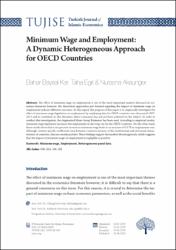Minimum Wage and Employment: A Dynamic Heterogeneous Approach for OECD Countries

View/
Access
info:eu-repo/semantics/openAccesshttp://creativecommons.org/licenses/by-nc-nd/3.0/us/Date
2018-08-15Metadata
Show full item recordCitation
Kar, B. B., Egri, T., & Aksunger, N.(2018) Minimum Wage and Employment: A Dynamic Heterogeneous Approach for OECD Countries, Turkish Journal of Islamic Economics, 6(2), 80-106Abstract
The effect of minimum wage on employment is one of the most important matters discussed in economics literature however; the theoretical approaches put forward regarding the impact of minimum wage on employment indicate different outcomes. In this regard, the purpose of this paper is to empirically investigate the effect of minimum wage legislation on employment by employing data for OECD countries over the period 1997-2017 and to contribute to this literature where consensus has not yet been achieved on the subject. In order to conduct this investigation, the Augmented Mean Group Estimator has been used. According to empirical results, minimum wage legislation increases the employment in the long run for the OECD countries. On the other hand, these results show that a one percent increase in minimum wage leads to an increase of 0.17% in employment rate. Although country-specific coefficients vary between countries because of the institutional and structural characteristics of countries, they are mostly positive. These findings support the modern liberal approach, which suggests that the impact of minimum wage on employment is negligible or positive.
Source
Turkish Journal of Islamic EconomicsCollections
- Makale Koleksiyonu [443]
- WoS İndeksli Yayınlar Koleksiyonu [1016]
The following license files are associated with this item:



















